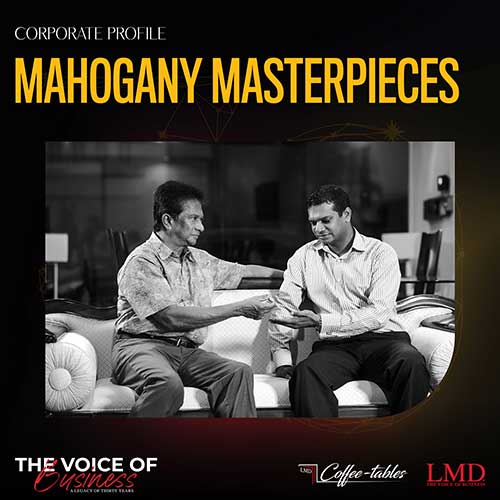LMD ARCHIVES
1996
Reversal of Culture
Anoma Peiris discusses the cultural transition from a wholehearted assimilation of Westernisation to the celebration of local products, customs and traditions

The timber is old, heavy, Kandyan period; the ironmongery is polished brass; the furnishings are creamy white, handloom cotton. The white, hessian drapes hang down from the ceiling to the jute carpet.
An old, wooden pettagama stands in the corner. On the glass tabletop is a wedding portrait from the turn of the century – father in top hat and coattails; mother in lacy Victorian gown, stockings and large feathered hat.
Sealed behind glass in an ornate silver frame, they preside over a carefully arranged collection of antique brass betel nut crackers.
Behind the sofa, in a halo of blue halogen light, is a large stone mortar, supporting a vase of half open white lotuses. On the wall behind it is a large oil painting of vibrant colours and primitive figures. Through the glass doors around the patio, we glimpse a stone carving of the elephant god Ganesha in a niche in the corner. The fragrance of white temple flowers is carried in with the evening breeze.
The lingering strains of Peter Gabriel and Nusrat Fati Ali Khan complete the ambience. The occupant, when he arrives, is Asian, clad in a black kurta and colourful silk sarong. He offers you a whisky on the rocks and bowlful of roasted cashew nuts, and prepares to be sociable…
Indeed, the curious layering of Eastern identity on a Westernised perception of the world is peculiar to a group of educated elites in Eastern societies in the post-independence period – a group that during colonial times, wholeheartedly assimilated Westernisation. The renewed interest in precolonial identities surfaced as an act of reclaiming a past that had once been rejected.
The ascent of the peasant object from the lowly status of everyday functionalism to objet d’art, the celebration of local products, customs and traditions, and the rejection of everything British, created a pattern through which cultural territory was repatriated and precolonial identities were revived. The resistant process manifested itself physically in the symbolic capital of the new nation, and extended to civil society in dress, manners and architecture.
The cultural elite who during colonial times set themselves apart from native society by imitating colonial culture – i.e. the role of the cultured gentleman – since reinterpreted themselves in terms of nationalist agenda, and were thus able to maintain their status in both society and government.
In political society, new symbols and traditions were invented to represent the indigenous identity – a national flag and anthem, national dress, national language and new architecture in the form of the independence monument. Road names were changed from British to local names and education was conducted in the vernacular. In civil society, the sari, kurta, shervanee and sarong all became fashionable.
Names lost their anglicised origins and borrowed instead from Buddhist or Hindu literature. Grandfather Harold had a son named Lakshmana. Artistes began to depict local subjects in paintings, drama and literature. Their subject matter was transformed from Victorian drawing rooms and gentlemen on horseback, to rural settings and Buddhist or Hindu scriptures. The culture of elite society had effected a complete reversal.
In architecture, the British style of PWD (Public Works Department) houses of the 1940s were discarded for American style architecture with butterfly roofs and concrete porches. This was followed by regionalism: an architecture that referred to and borrowed from the examples of its specific region.
In Sri Lanka, the walauwwa style abode (house of the rural headman) became an important example. The courtyard re-entered domestic space, along with Sinhala ulu (half-round tiles) and beeralu (ornate) columns.
Vernacular architecture was a style to be celebrated. The idea of what was fashionable in the domestic architecture of the local elite had shifted from Renaissance classical imitations to an architecture that looked and felt more Eastern.
But how did this reversal affect the marketplace or engage the lifestyles of the average citizen?
The majority had been wearing sarongs and building vernacular houses throughout the period of colonial occupation. Adult franchise and independence for the average citizen meant democracy and access at last to the Westernisation that was previously inaccessible.
The shirt, trousers and dress made affordable by a generation of synthetic fibres and mass-produced in an expanding local market provided the ready-made Western identity so long coveted.

Light plastic buckets replaced heavy earthenware vessels. Wattle and daub structures gave way to brick, mortar and asbestos – new and more permanent structures.
The average citizen was untouched by the need to preserve precolonial traditions because they had evolved through rigid hierarchies within which peasant positions were severely limited.
In the Kandyan kingdom for example, the king and royal court held exclusive rights to lime washing or tiling their own domestic dwellings, while the rest of the population were regulated to use straw or cadjan roofing and mud plaster.
The nostalgia for walauwwa style architecture was thus not shared by the majority of the people. The housing of the new middle classes instead veered towards reinterpretations of Western architectural styles… and emerged in a mixture of Spanish balustrades and classical columns. Elements were in turn supplied in large numbers and at little expense by an emerging industry in precast concrete decorations.
Not only in Sri Lanka but across the world, the democratic forces of the open market effected a similar transformation. Modernism, in its new post-World War interpretation, was changing the existing feudal structures.
The emergence of a large and economically stable middle class was affecting the face of dominant social culture. The media industry made art, music and drama easily accessible. In dress, blue jeans emerged as a symbol of worker clothing and social equaliser. The context of what was considered valuable in most societies had to undergo a complete reversal.
As cheaper synthetic fibres with their drip-dry, crease free surfaces transformed the clothing industry, handmade fibres entered the arena of elite fashion. As mechanisation enabled the mass production of ready-made garments, handstitched or individually designed garments demanded increased prices. Skilled labour demanded better wages.
If smooth surfaces and synthetic finishes were being mass-produced for the vast middle-class market, textures and rough fibres must then constitute the more exclusive end of the spectrum.
As large numbers of First World citizens rose above the poverty line, the perception of physical beauty underwent a similar reversal.
Where generous physical proportions had once implied wealth and the ability to afford food in excess, they have now become a symbol of poverty and bad diet. Increased wealth in turn increased the individual’s ability to afford regular exercise and a specialised diet.
In developing countries, where this perception holds little credence, beauty and obesity are yet paralleled. Film stars in Hollywood or on the Sinhala-language screen display a plumpness or stockiness in keeping with the wealthy, and are therefore a well-fed description.
Likewise, in skin colouration, the tanned complexion – which was once a natural indicator of long hours spent toiling in the sun – has grown into a wealthy affectation. To spend a holiday sun bathing in a tropical resort and acquire a perfect tan is both a sign of beauty and proof of affluence.
In the world of art, the new interest in vernacular cultures meant that rustic environments, primitive objects and designs were celebrated. Aboriginal motifs appeared on everyday objects such as T-shirts, mugs and wrapping paper. The ‘savage paradigm,’ as it was referred to, projected such cultures as timeless and frozen in the past; and glossy photographic records in a new coffee-table orientalism were published.
The hotel and resort industry that marketed such symbolic capital to its advantage fed on similar attitudes and projections. The reversal of culture and its allied impedimenta had become a viable commodity – an industry that could be exploited.
Today, as the neon cancer of the Galle Road marches relentlessly southward, we urban Sri Lankans mourn the loss of our rustic environs. The weekend drive from Colombo to one of the many beachside hotels is becoming increasingly unpleasant. Mud huts after all, are so much more ‘picturesque,’ even if they encourage lung infections in their inhabitants: a small price to pay for that truly Sri Lankan ambience.
Traditional culture (its symbols and representations) has failed to liberate the ordinary citizen. In refusing to adapt itself to suit and modify the aspirations of its people, it has been reduced to the symbolic capital of tourists and politicians. The reversal of culture and forces of mass production have overtaken the projections of a cultured elite, and failed to maintain territory within civil society and daily existence.
Outside on the street corner, the pavement hawkers are unpacking their boxes. Nylon shirts and bright plastic slippers are being stacked under a halo of plastic buckets. The horizon is a riot of pure colours and synthetic surfaces. Their clientele are the daily commuters, progressing in the direction of the railway station. A new Sri Lankan identity is being disseminated.





